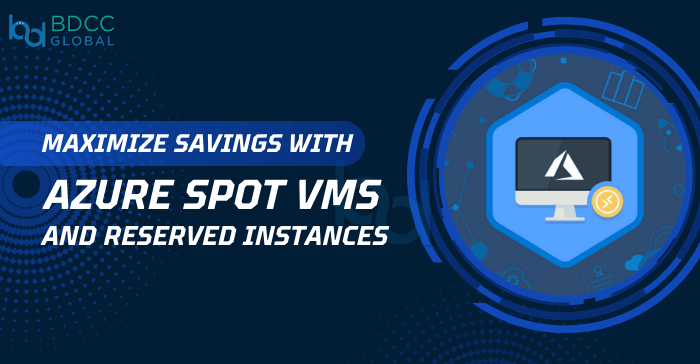
Many businesses unknowingly overspend on Azure VM cost management, missing out on cost-saving opportunities. What if you could cut costs by up to 90% without sacrificing performance? Azure consulting services offer two powerful pricing models for cost optimization in Azure and understanding how to balance both can significantly reduce your cloud expenses while maintaining efficiency.
This guide will walk you through Azure Spot VMs pricing, Reserved Instances, and hybrid cost strategies, helping you get the most value from your cloud infrastructure; whether you’re managing Azure DevOps services or scaling enterprise applications. Let’s dive in!
Also read about which cloud platform you should choose.
What are Azure Reserved Instances (RIs)?
Azure Reserved Instances (RIs) are a prepaid commitment-based pricing model that allows businesses to reserve virtual machine (VM) capacity for a specific period, one year or three years, in exchange for significant cost savings. Unlike the standard pay-as-you-go model, where users are charged based on real-time consumption, RIs provide discounted pricing by committing to a specific VM type and region upfront.
Key Features of RIs:
- Available for a wide range of Azure VMs, including General Purpose, Compute Optimized, and Memory Optimized instances.
- Offer flexibility in instance size and region (with certain limitations).
- Support automatic application to eligible VMs within a subscription, helping to reduce operational costs seamlessly.
Benefits of using RIs
- One of the biggest advantages of Azure VM cost management using Reserved Instances is the potential cost optimization in Azure—up to 72% savings compared to pay-as-you-go pricing.
- With a fixed pricing model, RIs provide businesses with clear financial planning.
- Azure consulting services help implement RIs efficiently to reduce unnecessary cloud expenses.
- Azure DevOps services can integrate RIs to ensure cost-effective infrastructure for development and CI/CD pipelines.
Use cases for RIs
Azure Reserved Instances are highly effective for scenarios where long-term infrastructure stability is required:
- Enterprise Applications – Ideal for ERP, CRM, and database servers that require long-term, stable resources.
- Web Hosting & SaaS – Ensures predictable costs for SaaS applications and websites with steady traffic.
- DevOps & CI/CD – Provides cost-effective compute power for continuous integration and deployment pipelines.
- AI & Machine Learning – Reduces Azure Spot VMs pricing for training models and running AI workloads over extended periods.
- Big Data Processing – Supports Apache Spark, Hadoop, and analytics workloads with dedicated capacity.
What is Azure Spot VMs?
Azure Spot VMs pricing allows businesses to use unused Azure compute capacity at a significantly lower cost than traditional on-demand pricing. Microsoft dynamically determines pricing for Azure Spot VMs pricing based on supply and demand in different Azure regions. When there is excess capacity, Spot VMs can run at discounts of up to 90% compared to pay-as-you-go rates.
However, the key difference between Spot VMs and standard virtual machines is preemptibility; meaning Microsoft can reclaim the resources at any time when demand increases. This makes Spot VMs ideal for workloads that can tolerate interruptions and do not require constant availability.
Key Characteristics of Spot VMs:
- Azure Spot VMs pricing provides deeply discounted pricing (up to 90% cheaper than standard VMs).
- No SLA (Service Level Agreement) guarantee—Spot VMs can be evicted when Azure needs capacity.
- Pricing varies depending on demand and available capacity.
- Best suited for fault-tolerant workloads that can handle interruptions.
Benefits of using Spot VMs
- The primary advantage of Azure Spot VMs pricing is substantial cost reduction.
- Spot VMs enable businesses to scale workloads affordably without committing to long-term reservations.
- Many applications do not require constant uptime, making Azure VM cost management more flexible.
- Azure DevOps services can use Spot VMs for test environments and CI/CD pipelines at a lower cost.
- Azure consulting services can help organizations integrate Spot VMs with autoscaling to balance availability and affordability.
Use Cases for Spot VMs
Spot VMs are ideal for workloads that can handle interruptions without affecting overall business operations. Below are some practical scenarios where Spot VMs can be effectively utilized:
- Batch Processing & Data Analytics – Ideal for financial simulations, big data, and analytics jobs that can restart as needed.
- AI & Machine Learning Training – Cost-effective for training ML models that don’t require continuous uptime.
- Media Rendering – Distributes video, animation, and 3D rendering tasks across multiple VMs at a lower cost.
- Dev/Test Environments – Provides affordable testing infrastructure for CI/CD pipelines and development work.
- Scientific Simulations – Supports high-performance computing tasks, such as genomic sequencing and weather modeling, at a fraction of the cost.
Choosing Between Reserved Instances and Spot VMs
The following table highlights the key differences between Azure Reserved Instances and Spot VMs to help businesses determine which model aligns best with their needs:
| Feature | Reserved Instances (RIs) | Spot VMs |
|---|---|---|
| Commitment Period | 1-year or 3-year commitment | No commitment, pay as you go |
| Availability | Guaranteed for the selected VM size and region | Not guaranteed, subject to eviction when Azure needs capacity |
| Best Suited For | Predictable, long-term workloads | Short-term, fault-tolerant workloads |
| Interruptions | No interruptions, full control | Can be stopped (preempted) at any time |
| Flexibility | Some flexibility in instance size and regio | Highly flexible, can scale workloads dynamically |
| Billing Model | Prepaid (one-time or monthly) | Pay only for consumed resources |

